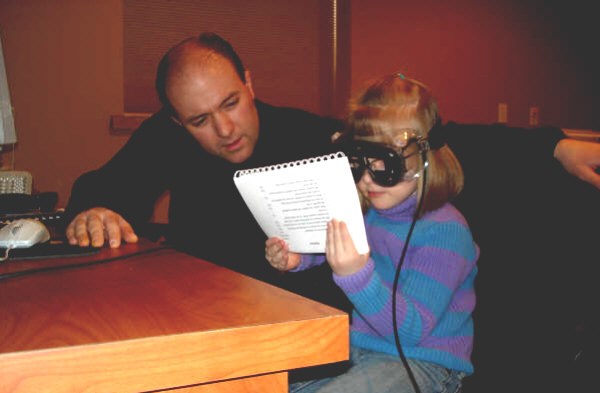
We use the Visagraph to confirm diagnoses of visual efficiency problems as well as quantify symptoms of reading dysfunction when a parent tells us his/her child is not performing to potential in school. The Visagraph--Technology for Identifying Learning-Related Vision Problems
|
||||||||||||||
| Printer Friendly Story View |
Exactly what the eyes are doing during reading is very difficult to measure by ordinary procedures. It is tough to quantify a patient's eye movements in terms of accuracy and consistency when the patient is looking at words on a page instead of a target in front of them held by the examiner.

Still, learning-related vision problems (a catch-all term including such things as visual efficiency problems and visual processing problems) tend to cause significant difficulty during the reading process.
The Visagraph is a computer-aided reading assessment program that allows eye care professionals to objectively measure eye movements made during reading and identify reading and learning problems.
The patient wears goggles that contain two infrared sensors in front of each eyepiece. When a passage is read, the sensors record every eye movement made, including a normal "hop" from left to right, regressions in the other direction to reread, and whether the two eyes moved consistently in the same direction and in the same amount during the time spent reading. The data analysis displays the results numerically and includes values such as fixations and regression per 100 words, reading rate in words per minute, and the extent to which the right and left eye movements were consistent.
The patient reads an age-appropriate passage (approximately one grade level below their current grade) and subsequently answers comprehension questions. The rationale is that if comprehension is average or better, the reading assessment will have been a valid assessment of their eye movements made during reading. If the passage were too difficult, for example, the patient would have to spend too much time deciphering words and therefore eye movements would probably be uncharacteristic of normal.
The company that manufactures the Visagraph has performed eye movement studies on thousands of patients, and therefore it can be assumed that the age-based norms accurately characterize patients who have good reading eye-movement skills as well as those who do not.
One important point that must be remembered, however, is that the Visagraph is not an intelligence test - it only measures the accuracy and efficiency of eye movements, not intelligence or potential. It therefore makes sense that I have seen patients with poor school achievement perform adequately on the Visagraph - as well as patients with very good grades in school perform poorly. In the latter case, the student is unfortunately having to exert tremendous effort to accomplish things that should be easy.
In my practice, we use the Visagraph to confirm diagnoses of visual efficiency problems as well as quantify symptoms of reading dysfunction when a parent tells us his/her child is not performing to potential in school. Some of these students will benefit from vision therapy, a process during which individual visual skills and processing skills are enhanced. Vision therapy alleviates problems that glasses can't - more on vision therapy in a future article. It is important to remember that the Visagraph can't "make" anything better - it can only help us identify problems and measure whether any therapeutic intervention has succeeded in improving the skills in question.
The most compelling feature of the Visagraph software is a real-time simulation of the patient's eyes during reading. Using a red target, the software shows actual eye position superimposed upon the text on the screen. In this manner, parents can easily see whether their child "regressed" (meaning made a right-to-left eye movement) significantly more than average. I like to look at it from the perspective of whether the reading activity generally showed a left-to-right progression - i.e. some regressions are normal, but excessive numbers of them certainly interfere with the processing and comprehension stages.
Eye coordination problems, such as those that involve difficulty holding fixation of the two eyes together at the same point in space, usually cause a reduced Visagraph result. Also, problems with sight word recognition will cause a patient to have a slower reading rate than expected as he/she will have to stop and decipher words that should have been recognized immediately.
Overall, the Visagraph has been a very worthwhile addition to our practice - both as its clinical utility in identifying eye movement problems and as a patient education and demonstration tool.
For more information, please visit our websites at http://www.newtonyecarecenter.com and http://www.wecurelearningproblems.com
As always, you can email me at drnewton@newtoneyecarecenter.com with specific questions about the content of the article.
I invite your questions and feedback
Or Contact Dr. Lee Newton at:
3720 E. Wilder Road, Bay City, MI
(989) 667-9393
3720 E. Wilder Road, Bay City, MI
(989) 667-9393
| Printer Friendly Story View |

|
Prior Article
March 5, 2025 by: Stephen Kent St. Patricks Parade 2025 - IT's TIME |

|
Next Article
February 10, 2020 by: Rachel Reh Family Winter Fun Fest is BACC Hot Spot for 2/10/2020 |
|
|

Dr. Lee Newton, Eye Care |
|
|
|
Printer-Friendly Story View
0200 Nd: 04-28-2025 d 4 cpr 0
12/31/2020 P3v3-0200-Ad.cfm
SPONSORED LINKS
12/31/2020 drop ads P3v3-0200-Ad.cfm
